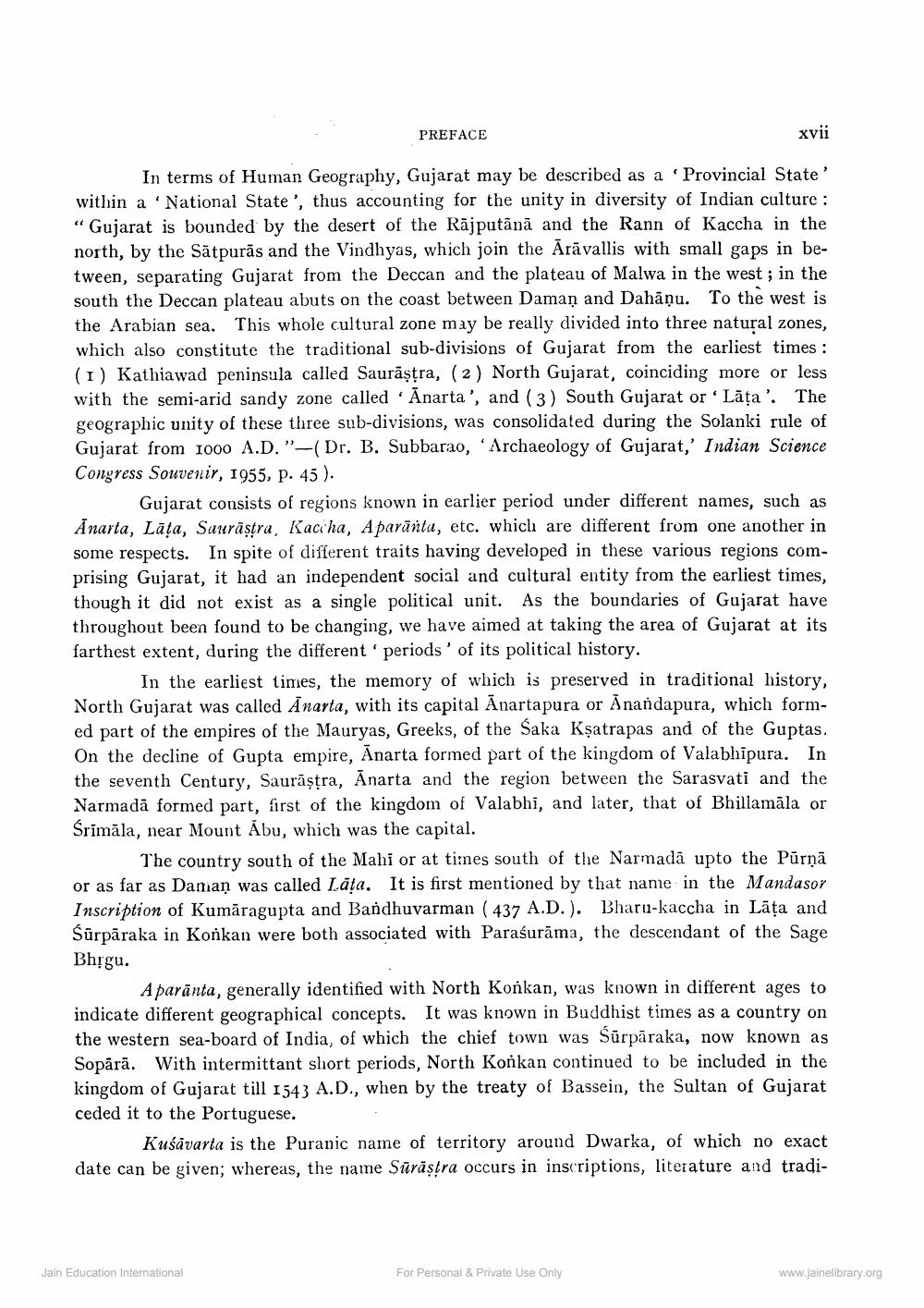________________
PREFACE
xvii
In terms of Human Geography, Gujarat may be described as a Provincial State' within a National State', thus accounting for the unity in diversity of Indian culture : “Gujarat is bounded by the desert of the Rājputānā and the Rann of Kaccha in the north, by the Sātpurās and the Vindhyas, which join the Arāvallis with small gaps in between, separating Gujarat from the Deccan and the plateau of Malwa in the west ; in the south the Deccan plateau abuts on the coast between Daman and Dahāņu. To the west is the Arabian sea. This whole cultural zone may be really divided into three natural zones, which also constitute the traditional sub-divisions of Gujarat from the earliest times : (1) Kathiawad peninsula called Saurāṣtra, (2) North Gujarat, coinciding more or less with the semi-arid sandy zone called Anarta', and (3) South Gujarat or * Lāța'. The geographic unity of these three sub-divisions, was consolidated during the Solanki rule of Gujarat from 1000 A.D."-(Dr. B. Subbarao, ‘Archaeology of Gujarat, Indian Science Congress Souvenir, 1955, p. 45).
Gujarat consists of regions known in earlier period under different names, such as Anarta, Lāța, Saurāstra, Kaccha, Aparūnta, etc. which are different from one another in some respects. In spite of different traits having developed in these various regions comprising Gujarat, it had an independent social and cultural entity from the earliest times, though it did not exist as a single political unit. As the boundaries of Gujarat have throughout been found to be changing, we have aimed at taking the area of Gujarat at its farthest extent, during the different periods' of its political history.
In the earliest times, the memory of which is preserved in traditional history, North Gujarat was called Anarta, with its capital Anartapura or Anandapura, which formed part of the empires of the Mauryas, Greeks, of the Saka Kșatrapas and of the Guptas. On the decline of Gupta empire, Anarta formed part of the kingdom of Valabhīpura. In the seventh Century, Saurāṣtra, Anarta and the region between the Sarasvati and the Narmadā formed part, first of the kingdom of Valabhi, and later, that of Bhillamāla or Śrimāla, near Mount Abu, which was the capital.
The country south of the Mahi or at times south of the Narmadā upto the Pūrņā or as far as Daman was called Lăța. It is first mentioned by that name in the Mandasor Inscription of Kumāragupta and Bandhuvarman ( 437 A.D.). Bharu-kaccha in Lāța and Śūrpāraka in Konkan were both associated with Paraśurāma, the descendant of the Sage Bhrgu.
A parānta, generally identified with North Konkan, was known in different ages to indicate different geographical concepts. It was known in Buddhist times as a country on the western sea-board of India, of which the chief town was Sürpäraka, now known as Sopārā. With intermittant short periods, North Konkan continued to be included in the kingdom of Gujarat till 1543 A.D., when by the treaty of Bassein, the Sultan of Gujarat ceded it to the Portuguese.
Kuśāvarta is the Puranic name of territory around Dwarka, of which no exact date can be given; whereas, the name Sürāstra occurs in inscriptions, literature and tradi
Jain Education International
For Personal & Private Use Only
www.jainelibrary.org




